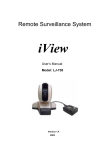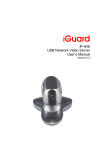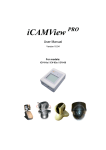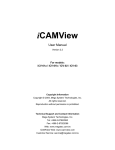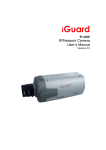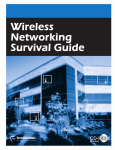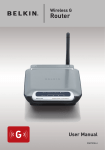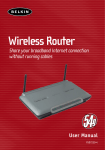Download iCAMView - SuperDroid Robots
Transcript
iCAMView User Manual ICAMView Manual 1 CONTENTS Chapter 1: Introduction________________________________________4 Section 1. Features___________________________________________4 Section 2. iCAMView as a Remote Surveillance System______________4 Section 3. Package Contents___________________________________5 Chapter 2: Installation Procedure________________________________7 Chapter 3: iCAMView, USB Camera and the Network________________7 Section 1. Installation Procedure________________________________7 Chapter 4: Using iCAMView Utility to Setup IP & Update Firmware____8 Section 1. Installing iCAMView Utility_____________________________8 Section 2. Using iCAMView Utility_______________________________9 2.1 Setup Wizard____________________________________________10 2.2 Launch iCAMView________________________________________13 2.3 IP Configuration_________________________________________14 2.3.1 IP Address____________________________________________15 2.3.2 Advanced_____________________________________________15 2.4 Upgrade Firmware_______________________________________17 2.5 LAN Connection_________________________________________17 2.6 Refresh________________________________________________17 Chapter 5: iCAMView Web Manager_____________________________17 Section 1. Introduction_______________________________________17 Section 2. iCAMView Web Manager Interface_____________________18 2.1 Web-Camera Selection____________________________________19 2.2 Information_____________________________________________21 2.2.1 System Status_________________________________________21 2.2.2 Current Connections____________________________________21 2.2.3 Event Log_____________________________________________21 2.3 Basic Settings___________________________________________21 ICAMView Manual 2 2.3.1 Camera Settings_______________________________________22 2.3.2 Network______________________________________________23 2.3.3 Account Settings_______________________________________26 2.4 Advanced Settings_______________________________________27 2.4.1 Event Notification_______________________________________27 2.4.2 Motion Detection_______________________________________29 2.4.3 Image Recording_______________________________________31 2.4.4 E-mail / FTP___________________________________________32 2.4.5 System Settings________________________________________34 2.4.6 Language_____________________________________________36 2.4.7 About________________________________________________36 Chapter 6: iMultiView_________________________________________37 Section 1. Installing iMultiView_________________________________37 Section 2. Using iMultiView____________________________________38 2.1 Device_________________________________________________38 2.2 View__________________________________________________45 2.3 System________________________________________________45 2.4 Drag-and-Drop Feature___________________________________46 Appendix A: Router Configuration______________________________47 Appendix B: Methods to Update iCAMView Firmware______________58 Appendix C: IP Address, Subnet and Gateway____________________61 Appendix D: Glossary________________________________________63 ICAMView Manual 3 Chapter 1: Introduction Section 1. Features iCAMView is a compact stand-alone web-server capable of remote video surveillance. It can be accessed from anywhere in the world via a standard browser by entering the IP, account and password. Each system can simultaneously support any two combinations of USB PC cameras be it regular, infrared or pan-tilt. With its built-in web-server, iCAMView can stream video images directly to the Internet without have to go thru a computer. iCAMView features a Windows-based software that allows the user to archive streaming video directly into the hard-drive. The same software also allows the user to monitor multiple cameras on one screen. Features: • Built-in Web Server • 10/100Mbps Fast Ethernet Network Access • Support Any Java-Enabled Web Browser • LCD display shows the IP address, Subnet Mask and Gateway • 32-Bit RISC CPU • 1MB Flash Memory • 8MB Dynamic Memory • Support Up to 30 Remote Viewers for each camera • Allow Up to 8 User Accounts and Passwords • 5.3VDC 1A Maximum • Operating Temperature: 0°C ~ 60°C • Operating Humidity: 10% ~ 90% • Dimensions: 48mm x 63mm x 21m • Weight: 75g • For Indoor Use. Protective housing required for use • Network Protocol: HTTP, TCP/IP, UDP, SMTP, PPPoE, Dynamic DNS, DNS Client, SNTP, BOOTP, DHCP, FTP, SNMP • Support All USB PC Camera with VIMICRO ZC0301 Plus processor built-in • Resolution: 640 x 480, 320 x 240, 160 x 120. • Frame Rate: Up to 20fps in 320 x 240 • MJPEG Compression • 2 USB Ports for PC Cameras • USB 1.1 & 2.0 compliant • Can combine with two different PC cameras • Support Pan/Tilt and Infrared USB PC Camera Section 2. iCAMView as a Remote Surveillance System Once iCAMView is installed, the user can check any of the connected PC ICAMView Manual 4 cameras using a standard web browser. The user can monitor and control these cameras simply by entering the IP address (set-up required with Netility) of the iCAMView from anywhere in the world as long as there is an Internet connection available. For instance, the user can be in Australia but is able to monitor his factory production in China and if he likes checks on his branch office located in Singapore, all this simultaneously. Fig.1 iCAMView Network Diagram Section 3. Package Contents Your iCAMView package should contain the following items; 1. iCAMView, 2. iCAMView Utility CD, which contains; a. iCAMView Utility: to configure IP address, update the firmware, etc. b. iMultiView: Windows platform to monitor multiple iCAMView. c. Time Server: Time adjustment utility. d. Adobe Acrobat 5.0 Reader. e. iCAMView user manual, and f. Camera Windows Driver 3. 5.3V DC Adapter ICAMView Manual 5 Fig.2 iCAMView Front View Fig.3 iCAMView Back View LED Status Indicators on iCAMView Light color Green Signal definition Condition description Power state On: Normal power Error Condition On: Error condition occurred Orange Logon state On: When there is user logon and receive the image. Yellow USB data activity Flash when there is data transmit/receive on the USB. Red Fig.4 iCAMView Status LED Indicator Light indicators on iCAMView LAN Port LED Light color Condition description Green On: Internet correspond speed is 100M Yellow Flash: Data transmitting/receiving On: Internet correspond speed is 10M Flash: Data transmitting/receiving Fig.5 iCAMView LAN LED Indicators ICAMView Manual 6 Chapter 2: Installation Procedure Before you start using iCAMView, you will need to set-up both the hardware and software. The following is a flow chart on the installation procedure: 5 iCAMView set-up completed 4 Use Internet Explorer (>5.0) to access iCAMView Web Manager (Chapter5). 3 Install iCAMView Utility (Chapter 4) and iMultiView (Chapter 6) 2 Connect Network cable to ROUTER / HUB / xDSL modem 1 Connect iCAMView, USB Camera and the Network cable (Chapter 3) Chapter 3: iCAMView, USB Camera and the Network The following details the installation procedure for iCAMView. Section 1. Installation Procedure Step 1: Connect the PC camera into the USB port of iCAMView. Step 2: Connect the iCAMView to LAN by using the Ethernet UTP port. Step 3: Connect DC power adapter output into iCAMView socket, and plug the DC power input into the wall socket Step 4: The LCD will display the IP, Subnet Mask and Gateway IP. Use a WEB browser to login into the iCAMView IP address. The icon on the LCD shows that a USB camera is connected. ICAMView Manual 7 The LCD display shows that two cameras are attached to the iCAMView. USB Warning: Please make sure the input Voltage and Frequency of the DC power adapter (DC 5.3V) is correct before plugging into the power outlet! Chapter 4: Using iCAMView Utility to Setup IP & Update Firmware Section 1. Installing iCAMView Utility 1. Insert the enclosed iCAMView CD into the CD-ROM drive. iCAMView setup will auto run. The following menu will show up. Click on the buttons on the left to installation the programs you want. iCAMView Utility - This is a program that helps the user perform quick installation. It will detect the current configuration and take the user thru the necessary network setup. a. Click the button to commence installation. b. After installation is completed, iCAMView Utility group will appear in Windows ’Start’ ‘Program Group’. Click this to start the program. ICAMView Manual 8 Fig.7 iCAMView Utility Group iMultiView - This is a windows based program designed to allow user to control a large number of iCAMView websites located either in a LAN or on a WAN. Read User’s Manual - Click to read iCAMView's User Manual. You will need Adobe Acrobat Reader v5.0 or higher. Adobe Acrobat Reader v5.0 - This will install Acrobat Reader v5.0 on your local hard drive. Sun Jave / ActiveX - Install Sun Java for viewing the video image by Java, or install the OCX for viewing by ActiveX. Section 2. Using iCAMView Utility When you start-up iCAMView Utility, it will search and list all available Network Card on your system (if more than one is installed). Select the Network adaptor that you are currently using and click “OK”. Fig.8 iCAMView Utility Network Adaptor Selection on Start-up The iCAMView Utility main menu is shown below. The selection menu is located on the left. The Serial Number, current Firmware and IP Address of every iCAMView connected to the LAN will be displayed on the table to the right. ICAMView Manual 9 Fig.9 iCAMView Utility Main Menu 2.1 Setup Wizard Use “Setup Wizard” to take you thru the basic configurations necessary to start using iCAMView. 1. Click to highlight the iCAMView on the right that you want to configure. 2. Click on “Setup Wizard”. 3. iCAMView Setup Wizard will initiate to take you thru the installation. 4. Enter the necessary camera configurations. Choose the appropriate frequency (Indoor 60 Hz, Indoor 50 Hz or Outdoor) to prevent flickering on the video feed. Enter a name for the camera in the “Location” box to easily identify it. 5. Click “Next >” to configure the Network Connection. ICAMView Manual 10 “Obtain an IP address by DHCP” Choose this if you do not know your basic Network Configurations “Use the following IP Address” Enter an appropriate internal IP Address, Subnet Mask and Gateway for iCAMView (Refer to Appendix C for an explanation of IP Addresses) “Obtain an IP address by Bootp” Allow iCAMView to obtain an IP address using Bootp protocol. 6. Click “Next >” to proceed to xDSL/Cable modem setup. This section has to be configured to allow iCAMView to access the Internet through an xDSL. Select “Enable PPPoE connection” and enter your account and password details as provided by your ISP. Otherwise, leave it at the default “Disable PPPoE connection” ICAMView Manual 11 7. Click “Next >” to proceed with DDNS setup or registration You will need to setup this section if you are using a Dynamic IP If you do not already have a Domain Name registered with your ISP, select from one of the 4 Free DDNS service providers (3322.org, dhs.org, dyndns.org or myddns.org). Follow the link to the respective free service providers to register a Domain Name and obtain a User Name and Password. Enter these details in the boxes provided 8. Click “Next >” to create an administrator account and password. An administrator account is necessary to ensure privacy. iCAMView can be viewed by anyone on the web. If you do not set one, WARNING: Do not lose the administrator account and password. Once set, you will not be able to configure iCAMView without the administrator account and password. 9. Click “Next >” to upload these configuration to iCAMView. ICAMView Manual 12 10. Click “Next >” to save and restart iCAMView with the new configurations. 2.2 Launch iCAMView Once you have finished with the above Setup Wizard, either click “Launch iCAMView” or double click on the iCAMView listed on the table to launch it. ICAMView Manual 13 Once you have done the above, the iCAMView login screen will appear. Key in the administrator account number and password entered earlier (if you did not input one, then just press ENTER or click on the “OK” button). Click either one to Launch iCAMView. The iCAMView webpage will appear. images. Click ActiveX for Camera A to view the video 2.3 IP Configuration ICAMView Manual 14 This section allows you to determine IP address configuration for iCAMView. Select the iCAMView on the right display screen, and then click “IP Configuration”. This will bring up the IP Address Configuration window. There are two tabs; • IP Address • Advanced (for port setting configuration) 2.3.1 IP Address Use this section to set the IP Address of iCAMView. When using iCAMView for the first time, it is advisable to choose the “Using Static IP Address” option. For this option, the user will have to enter an IP Address, Subnet Mask and Gateway of their choice (refer to Appendix C for IP address explanation). Fig.10 IP Configuration: Set an IP Address for iCAMView Once the IP Address is set, you will be able to connect to iCAMView webpage by entering this IP Address into a standard browser. “Obtain an IP address by DHCP or BOOTP” The IP address, Subnet Mask and and assigned automatically by the system. Gateway is acquired directly 2.3.2 Advanced This section sets security password devices thru iCAMView Utility. ICAMView Manual against unauthorised access to 15 Fig.11 IP Configuration: iCAMView Advanced settings i. Device Password Use this to set an access password to the individual device. Once set, the user must enter the password to access the device. In addition, the IP Address will not be shown on the right display panel of iCAMView Utility. iCAMView Utility will request for the “Input Device Password” when you click either “Setup Wizard”, “Launch iCAMView” or “IP Configuration” WARNING: Do not lose this password. If the password is lost, you can not access the device to make changes. To remove the password, you must first enter a valid “Input Device Password”, go to “Device Password” and delete the entries, click “OK”. ICAMView Manual 16 ii. Management Protocol The administrator can determine the parameter settings when providing access via HTTP (web) to iCAMView. For security reasons, the administrator can choose to use either an open or advanced port setting to control these access. The default values are set to port number 80 for HTTP. Once the HTTP port number is set to another port (other than 80), the full IP Address must be entered in order to access the Website. For example: If a value of 61 is set as the HTTP port number, then http://192.168.0.177:61 must be entered as the web address in order to access iCAMView website. Uncheck to disable this function. Devise Password not set. Devise Password enabled. IP Address hidden. 2.5 LAN Connection To switch to another Network Adaptor, click on “LAN Connection”. Fig.13 Netility version examined 2.6 Refresh iCAMView Utility automatically searches for any iCAMView connected to the LAN. However, the user can do a manual search by click the “Refresh” icon located at the bottom right of the menu. Chapter 5: iCAMView Web Manager Section 1. Introduction After you have setup the hardware and set an IP address for iCAMView, you will then be able to go to iCAMView web site to monitor and control the PC cameras. All you have to do is enter the new IP address into any web browser. 1. Start the Web Brower (Netscape or Internet Explore) ICAMView Manual 17 2. Enter the iCAMView IP Address that was set earlier using “Setup Wizard” (e.g. 211.21.67.51) and press ENTER 3. A login screen will appear. Enter the Administrator User Name and Password if you have set these in the “Setup Wizard”. Otherwise, just press ENTER. Fig.15 iCAMView Login screen Section 2. iCAMView Web Manager Interface The iCAMView webpage main menu is divided into two sections. The selection menu on the left and display menu on the right. The selection menu consists of the following options: 2.1 Web-Camera Selection 2.2 Information 2.3 Basic Settings 2.4 Advanced Settings ICAMView Manual 18 Fig.16 iCAMView Main Menu When using iCAMView for the first time, you must set the following to ensure that iCAMView works smoothly; a. Set the necessary parameters in the “Configuration” menu. In particular, the “Anti Flicker” under “Camera Settings” should be set to 50Hz or 60Hz (change this to 60Hz or 50Hz / Outdoor if video output continues to flicker). b. That the USB PC camera lens is adjusted for best results. By default the above Camera Settings page is displayed when you login. 2.1 Web-Camera Selection Click on either “ActiveX” or “Sun Java” from Camera A or B to view the camera images. By default the first USB camera connected to iCAMView will be denote as “Camera A” Click “Camera B” to view camera B. ICAMView Manual 19 Note: ActiveX can only function on Windows platform and a plug-in has to be installed on the client's computer. If this is prohibited for safety reasons you will have to use Sun Java to view the video feed. Sun Java also allows users who are not using Windows based Operating System to view the video feed. Once you click on “Camera A” the following image will appear. Make sure to adjust the USB camera lens for best picture results. Click on the controls along the Window to control the camera. Note: The pan and tilt controls will only work with cameras which has this function built-in. Click to record the current image to the selected directory. The default directory is C:\Program Files\Tophine \iMultiView To change the saved location and filename. Click and the “Save As” window will pop up. Choose an alternate location and filename. Click the “Save” button to confirm changes. To change Video Codec, click Note: The availability of Codec depends on weather the individual user has it installed on the PC or not. Download and install Windows MediaPlayer9 to enable MPEG4 codec. Digital Zoom In, Digital Zoom Out Rotate Left, Rotate Right Flip the image vertically. ICAMView Manual 20 Auto Pan the camera Pan Left by 5 deg / Pan Left by 1 deg. Pan Right by 1 deg / Pan Right by 5 deg. Tilt Up by 5 deg / Tilt Up by 1 deg. Tilt Down by 1 deg / Tilt Down by 5 deg. 2.2 Information The “Information” tab contains the following subsections; 2.2.1 System Status, 2.2.2 Current Connections and 2.2.3 Event Log. 2.2.1 System Status This section displays all the information relating to iCAMView. i. System Information This section shows iCAMView System Information such as the Hardware and Firmware Version, the serial number, current / local System Time, the system contact, location and uptime. These values are either name, provided by iCAMView or set by user. Fig.17 iCAMView System Status ii. System Information This section shows iCAMView Network settings. The MAC Address is unique to every iCAMView. All the other values are set by the user in Setup Wizard. 2.2.2 Current Connections This section will show all the users currently viewing either Camera A or Camera B. It also lists, the login time, and total bytes received. The user has an option to block the IP or even disable the account of any errant viewer. The administrator privilege will be required for this feature. A total of 10 connections can be displayed at the same time. ICAMView Manual 21 Fig.18 iCAMView Current Connections 2.2.3 Event Log This section will keep a record of all events that occurred in iCAMView. The user can Refresh, Clear or Save the log file. There is also an option to sort the logs according to “Level” or “Type” iCAMView can log up to 2,000 events Fig.19 iCAMView Event Log 2.3 Basic Settings Please ensure that each of the following option is set correctly. Otherwise, iCAMView may not work properly. 2.3.1 Camera Settings 2.3.2 Network 2.3.3 Account Settings 2.3.4 Camera Settings ICAMView Manual 22 Use this section to set up the USB camera. i. Setting up Camera A (Similar with Camera B) Fig.20 Individual Camera Configuration “Anti Flicker” Choose between 50Hz, 60Hz or Outdoors. Note: If you do not choose the right frequency, the image will flicker or lines will appear on the images. “Maximum Number of Connections (1-30)” Use this to limit the number of users that can connect to this camera. “Location” Enter a suitable location / name for the camera. “Exposure (1-100)” Set this to “Auto”, or Click “Manual” to fix the exposure. “Light Compensation” Choose “Yes” and iCAMView will increase the lighting of the image. This is useful when monitoring indoors. Choose “No” if you do not want iCAMView to adjust the light and view the images as is. “Color” Choose “Yes” for color and “No” for black and white display. “White Balance” Choose “Auto” to let iCAMView make auto adjustment. To adjust this manually, select “Manual” from the drop down menu, and then enter a suitable number for Red, Green and Blue. Click “Apply” to save changes. Otherwise, all changes will be lost. 2.3.2 Network This option determines the iCAMView Network settings. i. IP Address These items were all setup earlier in Setup Wizard. click “Apply” to change. ICAMView Manual Enter new addresses and 23 Fig.21 iCAMView IP Address Settings “IP Address” This item determines iCAMView IP Address. “Subnet Mask” This item sets iCAMView Subnet Mask. The value is normally 255.255.255.0 “Gateway” This item is to set iCAMView Gateway. “Obtain an IP address” This allows the user to choose either to set iCAMView IP Address manually or via DHCP. iCAMView will reboot after the above settings have been changed. ii. DNS Server IP Fig.22 iCAMView IP DNS Server IP “Primary DNS Server IP” This item sets iCAMView primary DNS Server IP address. “Secondary DNS Server IP” This item sets iCAMView secondary DNS Server IP address. iCAMView will use the secondary DNS Server IP address if the Primary DNS Server IP address is not working. iii. Port Number Fig.23 iCAMView Port Settings “HTTP Port Number” By default the port number is 80 “Communication to Camera Port Number” By default the port number is 9001 iv. Ethernet Fig.24 iCAMView Ethernet Settings ICAMView Manual 24 “Connection Type” This item sets the communication speed between iCAMView and the Network. iCAMView will reboot after “Connection Type” is changed. v. Dynamic DNS Fig.25 iCAMView Dynamic DNS Settings “Service Provider” The iCAMView can be configured to register the current IP to a dynamic DNS provider. This will enable you to locate iCAMView’s IP every time the IP changed due to an ADSL connection redial. Before you use this function, you will have to register with either one of these four service providers; • None (Select this to disable the DDNS function) • 3322.org • dhs.org • dyndns.org • myddns.com “Domain Name” :Enter the Domain Name you have created from one of the four websites. “Login Name” : Enter your login name for the above domain name. You only have to configure once. “Login Password”: Enter your password. You only have to configure once. vi. PPPoE Use this option to allow iCAMView to directly dial-up using your xDSL modem and connect to the Internet. Once set-up, iCAMView will be able to stream the video images directly to the Internet without going thru a IP router. Fig.26 iCAMView PPPoE setting “When Connection should be made” The user has a choice of; Disabled Connect always : : Default setting. iCAMView does not dial in iCAMView will automatically dial in. “Login Name” Enter your login name ICAMView Manual 25 “Login Password” Enter your password 2.3.3 Account Settings This section allows you to set up to eight (8) user account with different permissions for iCAMView. i. User Account “User Name” : Determine the username of visitors who can log in. The administrator can set up to 32 case sensitive character names. “Password” : Set a password for the visitor’s account. The administrator can set up to 32 case sensitive passwords. “Permission” : Determine the permission level to one of “Administrator”, “Operator”, “Viewer” or “No Access” Administrator: Operator: Viewer: No Access: This permission allows the user full access including write permission to all the sections. This permission level allows the user access to iCAMView menus, but without the permission to amend them. The administrator can also set “Permit Hours” here for seeing camera. This permission level allows the user to access iCAMView at specific time as set in “Permit Hours” for seeing camera. The user does not have write permission and only access the “Web Cam” and “Information” section. This is to revoke either of the above two permission levels given to a user. And make the user account disable. WARNING: If you did not setup the Administrator account in Setup Wizard; you MUST now set an Administrator permission level BEFORE setting either “Operator”, “Viewer” or “No Access”. Failure to do so will result in you being locked out of iCAMView Web Manager! “IP Filter” Visitor can only login from the IP address specified here for security consideration. You can restrict a user access only from 192.168.1.0/24 by setting up “192.168.1.*”. Otherwise, leave it as “*.*.*.*” to allow the user to login from any place. Fig.27 iCAMView User Account Settings ICAMView Manual 26 “Max FPS” This allows the administrator to determine the frames per second (“FPS”) allocated to each type of account. By limiting the FPS, the administrator can manage the limited bandwidth available. The administrator can set a figure between 1 to 20 and unlimited FPS. “Permit Hours” When the Permission level is set to either “Operator” or “Viewer”, the Administrator can configure and determine the time to which either permission level can access the camera. Click “Configure” to bring up the following window. You can set up to 4 different Permit Hours (in 24hr format). Click “Apply” to save and “Close” to exit. Fig.28 iCAMView Permit Hours Configuration 2.4 Advanced Settings Please ensure that each of the following option is set correctly. Otherwise, iCAMView may not work properly. 2.4.1 Event Notification 2.4.2 Motion Detection 2.4.3 Image Recording 2.4.4 Email / FTP 2.4.5 System Settings 2.4.6 Language 2.4.7 About 2.4.1 Event Notification This section determines the type of event an email is sent by iCAMView. iCAMView can send notifications to up to 8 email recipients. Note: You must have Administrator ICAMView Manual 27 privilege to edit this section. Fig.29 iCAMView Event Notification Page i. Event Notification “Send Email” To activate Event Notification, you will need to set “Send Email” to “Yes”. Select “No” if you do not wish to send out any notification. “Email Server” A valid “Email Server” with username and password (if authentication is required) must be made available for this feature to work. If you do not have this setup, or wish to change the settings, click on “Edit”. “Email Address Book” There must be at least one valid email address in the address book. The default email is just a sample. If you wish to add or delete entries in your address book, click “Edit”. “Recipients” iCAMView can send email notification to up to 8 valid email accounts. To add an . To remove, click . email to the recipient list, click “Events” This section determines the events that the selected recipients will be notified of by email. There are three types of events, Information, Warning and Error. Click to select from the list of events you wish these recipients to be notified of. ICAMView Manual 28 Fig.30 iCAMView Event Selection List By default, all the events are selected; you must click “Apply” to activate them. Click “Apply” to save Close the window to return to the Event Notification Page. your settings. iCAMView will send you the following email notification depending on which event you have selected. Note: The image recording and motion detection notification function here will send For email notification with an email notification WITHOUT any pictures attached. images, the administrator has to setup the Image Recording Page and Motion Detection Page under Advanced Settings. Samples; 2.4.2 Motion Detection This page allows the administrator to set motion detection functions for the cameras. ICAMView Manual 29 i. Camera A (or Camera B) “Enable” To activate motion detect, the administrator has two options; a. “Always On” or b. “On Schedule”, the administrator can set up to 4 different time slots for motion detection. “Detection Sensitivity” This will determines level of change before motion capture is triggered. “Send image every” Select a value between 1 to 5 seconds. “Stop sending emails after ## email(s) or image idle for ## second(s)” iCAMView will stop sending on the lower of the two conditions. You can Emails can be set from 1 to 99999 set between 1, 3, 5, 7 and 10 seconds. pieces, or 0 for stop sending email only when image idle occurred. “Schedule” If set to “On Schedule” in the above section, the administrator can then input the four preferred schedule time slots for motion detection. Time must be entered in 24hr format. Fig.35 iCAMView Motion Detection Page “Send to FTP Server” This option allows the administrator to send and store the motion detected images on a FTP site. This is useful for future reference and recording purpose. Click “Yes” to activate. “ftp://<empty>/<folder>” This box allows the administrator to determine the file location within the FTP site. ICAMView Manual 30 If you have not entered a FTP server, the above will be left <empty>. To setup the FTP server, click “Edit” to go to the Email / FTP Page. Once you have entered the FTP server, login name and password, click “Apply” and then Click on “Motion Detect” to return here. Enter a directory or folder name in <folder>. Click “Apply” when done. “System Defined / User Defined” The administrator can also determine to either have the system automatically assign the filenames for the pictures saved. Or assign these filenames. “Filename” Give the motion detected JPG images a standard filename prefix, to be followed by looping number suffix. “Loop from ## to ##” This will determine the number of suffixes preceding the above filename. Once the last number is reached, the first file will be replaced by the most current image. “Digits” This will determine the number of digits assignable for the above number suffix. The administrator can choose to assign between 1 to 6 digits. Click for an example. “Send Email” To send an email notification of Motion Detection with image, choose “Yes”, otherwise choose “No” “Email Server” The administrator will have to set this up. Otherwise, click “Edit” to go to the Email / FTP Page to make the necessary configuration. Click on Motion Detection to return here. “Recipient” & “Email Address Book” The administrator can determine who shall receive email notification. To add to the recipient list, either double click on the email in the address book or click . To add all the email address at once, click entry click , or Click to confirm and save the above settings. . To remove an to remove all entries from the recipient list. 2.4.3 Image Recording Image recording allows the user to receive an image to either their email account or to a FTP server. The images will be sent over a predetermined interval and a certain period. ICAMView Manual 31 Fig.37 iCAMView Image Recording Page i. Camera A (or Camera B) “Begin – End (hh:mm)” The administrator can determine up to 2 time slots when Image Recording is active. The time is in 24hrs format. “Send image every ## minute(s)” The administrator can determine the exact interval at which iCAMView capture and send an image. Choose among 1, 3, 5, 7 and 10 minutes. “Send to FTP Server” & “Send Email” This is similar to the function available in Motion Detection Page. Please refer to section 2.4.2 for details. 2.4.4 E-mail / FTP This section sets up the necessary Email and FTP server information. The administrator will have to enter a valid Account Name and Password to the Email server and/or FTP server. This information is necessary to allow email notification and ftp file sending features in Advanced Settings. ICAMView Manual 32 Fig.39 iCAMView Email / FTP Page i. FTP Settings “FTP Server” The administrator will have to enter the FTP server address here. “Account Name” Enter the FTP account name here “Password” Enter the corresponding password. Click “Apply” to save the above settings. ii. Email Settings “E-mail Server” The administrator will have to enter the Email server address here. “Sender’s Email Address” This will determines iCAMView’s Email address. “Email Server Requires Authentication” If set to “YES”, the administrator will have to provide the account name and password in order to access the Email server. Otherwise, enter “NO”. “Account Name” Enter the account name or login name to the Email server. “Password” Enter the password for the above account name. Click “Apply” to save the above changes. iii. Email Address Book Enter an Email address in the box provided and click “Add Email Address”. The new email address will be added to the list. The administrator can store up to 20 email addresses here. ICAMView Manual 33 To delete an Email address, just press “Delete”. 2.4.5 System Settings This page allows the administrator to set iCAMView SNMP settings so it can be used by a NMS (Network Management System) like iMultiView. i. System Time Fig.41 System Time “Time Between Automatic Updates” The administrator can set an interval for time synchronization. Select either 1, 3, 12 hours or 1, 10 & 30 days. “Time Server” Choose the nearest Time Server to your iCAMView location. The administrator can choose from the list of a maximum of 30 Time Servers. To add a new Timer Server the administrator must first make space by deleting some Time Servers. Once this is done, the add dialog box will appear as below. Click “Back” to return to the System Settings Page. ICAMView Manual 34 Fig.42 List of Time Server “Time Zone (Relative to GMT)” Select the appropriate time zone for your area. Click “Apply” to save. “System Time (yyyy/mm/dd hh:mm:ss)” This section is to manually set iCAMView System The format is pre-determined to: yyyy/mm/dd hh:mm:ss. Click Adjust” to save any manual changes. Time. “Manual ii. System Restart Fig.43 Auto Restart setting “Auto Restart System Every” The administrator can choose to restart iCAMView at certain intervals (choose between minutes and hours only). This will ensure that iCAMView will work smoothly. Click “Apply” to save changes. “Manual Restart” Click “Restart Now” to restart the system immediately. iii. LED Settings “LED function” The administrator can enable or disable the LED (except the Power LED) on iCAMView here. Click “Apply” to save settings. iv. SNMP Settings ICAMView Manual 35 ”System Name” This is to give iCAMView a name identifiable in a SNMP network. “System Contact” This is to give the administrator a name. “System Location” This is to set iCAMView location. “Manager IP Address” This set the IP address where the administrator can manage iCAMView from. It is valid for up to 8 IP addresses. To manage iCAMView from any IP addresses leave it as *.*.*.*. “Community” This is to set a Community name for NMS. The community name has to be the same as that set in NMS. “Permission” This is to set the administrator’s authority. Options are Read, Read/Write, and No Access. “Description” This is for an administrator to make notes. 2.4.6 Language Use this section is to set iCAMView Interface language. i. Interface Language At the moment, the administrator can only choose between; English, Chinese (Traditional) and Chinese (Simplified). ii. Email Preference Click “Yes” to apply language interface to Email notification. 2.4.7 About The administrator can use this section to check firmware information, save/restore settings, upgrade firmware and see manufacturer’s details. i. About This section gives crucial information about iCAMView’s Firmware Version, Hardware Version and Serial Number. These are required information for service calls. ICAMView Manual 36 ii. Save / Restore Settings “Save current Configuration” Click “Save” to save the current settings and configuration to your PC. The text file will have a default format of YYYY_MMDD_####.cfg. The administrator can change this, if necessary. “Restore previous configuration” This function is only available if a setting has been saved initially. Browse to the location where the file is saved and click “Restore” “Reset to factory default” This function will reset all settings to its default value. Fig.44 iCAMView About Page Chapter 6: iMultiView iMultiView is a program to manage multiple iCAMViews in a network. It is able to detect the IP’s of all the iCAMViews installed, and display them in a list form for easy management. Section 1. Installing iMultiView Click on setup.exe and follow the installation wizard After installation, there will be a iMultiView group in the Windows Start group Click “iMultiView” “iMultiView for Windows” to start using iMultiView. ICAMView Manual 37 Section 2. Using iMultiView After the iMultiView program start up the following main windows will be displayed. 2.1 Device Start iMultiView and press the “Enumerate” button, iMultiView will start a search for all the iCAMView on network and list them in the main window. ICAMView Manual 38 Manually adds the iCAMView to be monitored. Enter the assigned iCAMView IP Address. Port Number by default is 9001. You will have to enter the account and password if one has been set earlier. Otherwise just press “OK”. Once detected, the following will show in the main window: This shows that the camera is online and active. This shows that the camera is off-line Highlight the iCAMView to be deleted from iMultiView’s list. Click “Yes” to confirm deletion of selected iCAMView. : Display the General iCAMView settings. Key in a Host Name and Location for the camera. ICAMView Manual 39 Display the current Camera settings. Camera Select: Select either camera A or B Image Zoom: Resize the window to between 25% and 200% Camera Rotation: Rotate the image if necessary Mirror the Image: To mirror the image. Maximum frame per Select from 0.01 fps to a maximum of 30.00 fps. second: Display the Motion Detection Settings. ICAMView Manual 40 Enable Motion Detect: Click the checkbox to enable Motion Detection. Note: This function requires the Camera Window be active. Click “Monitor” to activate the Window. Choose from 0% to 100% (very sensitive) Sensitivity: Image Recording Click Start Recording when Motion Detected to enable the feature. Click the “Details..” button for the following option; Image Compression: Recording AVI File Path Choose from the list of available compressions. Note: This list is dependent on the Codec available / installed on the local PC. that is Location where the file will be recorded to. By default, it is recorded to c:\Program Files\Tophine \iMultiView. Click “Browse” to change the file location. Recorded files are save using the following file extension; CMV[year][month][date][hour][minute][seconds]. The time here denote the record start time. Note: Use the “Detail View” to check the record stop time. You can change the display view or add a new folder here. Stop after idle for: ICAMView Manual Set the value between 1 to 100 seconds 41 Send AVI file Send an AVI file via email in the event any motion is detected. Notification by Email: Configure Settings for Email Notification You will need to configure the “Message Sender Information” in order for iCAMView to send emails. Server Require Authentication Click “settings…” Enter your Account Name and Account Password if your Server Requires Authentication. Notified Email Address Click “Add…” and enter a new Email address below ICAMView Manual 42 Click “Modify…” to modify the entered Email Address Click “Delete” to remove an email address from the notification list. Highlight the iCAMView in the main click “Monitor” to view the video stream. windows display, and : Move the curser over the edges of the picture and it will turn into an Click and hold to pan / tilt the camera (if arrow. the camera supports this function) Click this button to record the current image on screen. A window will come up, click “Start” to start recording to the default file and location. Flip the image vertically ICAMView Manual 43 Rotate Left, Rotate Right , Click this to bring up the Setting windows. Click this to switch to full screen view. Double click to switch back to current view. Click and drag to resize the window and it’s contents. Click the left side of the viewing window to bring out more control features. Clicking once will cause the camera to pan left by 1 deg. Click and hold and the camera will pan increasingly faster to the left. Clicking once will cause the camera to pan right by 1 deg. Click and hold and the camera will pan increasingly faster to the left. Click once to tilt the camera up by 1 deg. Click and hold and the camera will tilt increasingly faster upwards. Click once to tilt the camera down by 1 deg. Click and hold and the camera will increasingly faster downwards. ICAMView Manual tilt 44 Auto Pan (if camera which support this function) 2.2 View Large icon display Small icon display 2.3 System Display the Event Log (IP address, Port, date, Time, description of event) of the selected iCAMView. : ICAMView Manual 45 Set the SNMP Parameter. : 2.4 Drag-and-Drop Feature iMultiView also feature a “Drag-and-Drop to Desktop” feature. Double click the icon on your desktop to view the images immediately. Useful if you are monitoring multiple cameras at a time. Step 1: Select the camera location of your choice. Step 2: Left click, hold and drag it onto the desktop. ICAMView Manual 46 Release the mouse button anywhere on the desktop and a new desktop icon is created there. Step 4: Double click on the icon on the desktop, to view the images. Appendix A: Router Configuration The following section describes the initial configuration of the router and port forwarding for your router. If your router is not listed here, please refer to the manufacturer’s website for assistance with configuring your router to work with iCAMView. Port Forwarding for iCAMView iCAMView requires certain ports to be open on your router to allow other computers on the Internet to “see” it on your internal network. Normally, your router will have the less common ports disabled or blocked by the router’s built-in firewall. In order for the iCAMView applications to work properly and not be blocked, the firewall settings need to be configured. In each instance there will be a trigger port and incoming port(s), where traffic on the trigger port tells the Firewall to open the incoming ports. The iCAMView ICAMView Manual 47 require that TCP Port 80 and UDP 9001 (default settings) be opened to the Internet. TCP Port 80 is used for accessing the camera’s homepage and UDP Port 9001 is used for authentication and video streaming. If your Internet service Provider blocks port 80/9001, you’ll need to reconfigure your camera and router to other ports such as 81/9002, 82/9003, etc. To change the port settings on the camera, you’ll need to use Netility. Follow the steps below to configure your router, depending on the router manufacturer and model. If your particular router manufacturer or model is not listed below, please contact your router manufacturer for further assistance in configuring the router. The Following Router manufacturers and models are included in this document: Brand 3Com Model 3C857-US 3CRWE52196 Belkin F5D6230-3 F5D7230-4– 54g DI-604/DI–614+/DI-624 DI-704/704P DI714 DI-714P+ D-Link Description OfficeConnect Cable/DSL Gateway OfficeConnect Wireless Cable/DSL Gateway Wireless Cable/DSL Gateway Router Wireless DSL/Cable gateway Router - Dell TrueMobile 2300 Broadband Router Wireless Linksys BEFSR41 BEFSX41 EtherFast Cable/DSL Router Instant Broadband EtherFast Cable/DSL Firewall Router with 4-Port Switch/VPN EndPoint Wireless Access Point Router with 4-Port Switch – Version 2 Wired Base Station Wireless Base Station Web Safe Router Wireless Router Cable/DSL Wireless Router ProSafe VPN Firewall BG-2000 - BEFW11S4 Microsoft NETGEAR Proxim Siemens MN-100 MN-500 RP614 MR814 MR314 FVS318 ORiNOCO Broadband Gateway SpeedStream 2602 SpeedStream 2623 ICAMView Manual - 2-Port DSL/Cable Router Wireless DSL/Cable Router 48 SMC Wireless SpeedStream 2604 SpeedStream 2624 SMC2404WBR SMC7004VBR SMC7004CWBR SMC7004AWBR 4-port DSL/Cable Router Wireless DSL/Cable Router Barricada Turbo 11/22 Mbps Cable/DSL Broadband Router Barricada Cable/DSL Broadband Router Barricada Wireless Cable/DSL Broadband Router Barricade 4-port 11Mbps Wireless Broadband Router 3Com (http://www.3com.com) 3C857-US – OfficeConnect Cable/DSL Gateway 3CRWE52196 – OfficeConnect Wireless Cable/DSL Gateway 1. Log into your router. 2. On the main page, select Firewalls on the left side of the page. 3. Select the Virtual Servers tab at the top of the page. 4. Click New on the right side of the page to open the Virtual Server Settings dialog box. 5. Type in the camera’s IP address in the Server IP address text box. (Look on the iCAMView IP address LCD display for the last 3 digits of the camera’s IP address.) 6. Under Local Service, select Custom. 7. Under Custom Service Name, type in: iCAMView. 8. Under Specify Custom Service Ports, type in: 80, 9001. 9. Click Add to save the settings. The iCAMView should now be configured to work with your router and be accessible from the internet. Belkin (http://www.belkin.com) F5D6230-3 – Wireless Cable/DSL Gateway Router 1. Log into your router. 2. On the main page, select Virtual Server on the left side of the page under the Securit section. 3. Enter the following information on the page: Line #1: Private IP: PrivatePort: Type: Public Port: ICAMView Manual Type in the camera’s IP address. (Look on the iCAMView IP Address LCD display for the last 3 digits of the camera’s IP address) 80 TCP 80 49 Line #2 Private IP: Private Port: Type: Public Port: Type in the camera’s IP address. (Look on the iCAMView IP Address LCD display for the last 3 digits of the camera’s IP address) 9001 UDP 9001 4. Click Enter to save the settings. The iCAMView should now be configured to work with your router and be accessible from the internet. F5D7230-4 – 54g Wireless DSL/Cable gateway Router 1. Log into your router. 2. On the main page, select Firewall on the left side of the page. 3. Under Firewall, select Virtual Servers. 4. Enter the following information on the page: Line #1 Enable: Description: Internet Port: Checked in iCAMView - Webpage 80 to 80 Type: Private IP address: Private Port TCP Type in the camera’s IP address. (Look on the iCAMView Address LCD display for the last 3 digits of the camera’s IP address) 80 to 80 Line #2 Enable: Description: Internet Port: Checked in iCAMView – Camera 9001 to 9001 Type: Private IP address: Private Port UDP Type in the camera’s IP address. (Look on the iCAMView Address LCD display for the last 3 digits of the camera’s IP address) 9001 to 9001 5. Click Apply Changes to save the settings. The iCAMView should now be configured o work with your router and be accessible from the internet. D-Link (http://www.dlink.com) DI-604/DI – 614+/DI-624 1. Log into your router 2. On the main page, click on Advanced at the top of the page. 3. On the left side of the page, click on Virtual Server. Note: Make sure DMZ host is disabled. If DMZ is enabled, it will disable all Virtual Server entries. ICAMView Manual 50 4. Enter the following information on the page: Enable/Disable: Name: Private IP: Protocol Type: Private Port: Enabled iCAMView - Webpage Type in the camera’s IP address, for example: 192.168.0.5 TCP 80 Public Port: Schedule: 80 Always 5. Click Apply to save the settings. 6. Enter the following information on the page: Enable/Disable: Name: Private IP: Protocol Type: Private Port: Enabled iCAMView - Webpage Type in the camera’s IP address, for example: 192.168.0.5 UDP 9001 Public Port: Schedule: 9001 Always 7. Click Apply o save the settings. iCAMView should now be configured to work with your router and be accessible from the internet. DI-704/704P 1. Log into your router 2. On the main page, click on Advanced at the top of the page. 3. On the Virtual Server page, enter the following information; For ID#1: Service Port: Service IP: Enabled/Disabled: 80 Type in the camera’s IP address, for example: 192.168.0.5 Enabled For ID#2 Service Port: Service IP: Enabled/Disabled: 9001 Type in the camera’s IP address, for example: 192.168.0.5 Enabled 4. Save your settings. iCAMView should now be configured to work with your router and be accessible from the internet. DI714 1. Log into your router 2. On the main page, click on Advanced at the top of the page. 3. Click on Virtual Server Settings on the left side of the page. 4. Enter the camera’s IP address into the Internal IP field. Under Service, select ICAMView Manual 51 All and then click Submit to save your settings. iCAMView should now be configured to work with your router and be accessible from the internet. DI-714P+ 1. Log into your router 2. On the main page, click on Advanced at the top of the page. 3. On the left side of the page, click Virtual Server. 4. Enter the following information on the page: For ID#1: Service Port: Service IP: Enabled/Disabled: 80 Type in the camera’s IP address, for example: 192.168.0.5 Enabled For ID#2 Service Port: Service IP: Enabled/Disabled: 9001 Type in the camera’s IP address, for example: 192.168.0.5 Enabled 5. Click Apply to save your settings. iCAMView should now be configured to work with your router and be accessible from the internet. Dell (http://www.dell.com) TrueMobile 2300 Wireless Broadband Router 1. Log into your router 2. On the main page, click on Advanced Settings at the top of the page. 3. Go to the Port Forwarding section and select Custom Port Forwarding Settings. 4. Check the Enable box. 5. Enter the desired name or description in the Service Name field such as iCAMView Web. 6. In the Incoming Ports field, specify port 80 in both boxes. 7. In the Destination IP Address field, enter the IP address of iCAMView 8. In the Destination MAC Address field, enter the MAC address of iCAMView. You can find the camera’s MAC address by either looking at the MAC address sticker on the bottom of the camera or by utilizing iCAMView setup utility to display the MAC address. Linksys (http://www.linksys.com) BEFSR41 – EtherFast Cable/DSL Router BEFSX41 – Instant Broadband EtherFast Cable/DSL Firewall Router with 4-Port Switch/VPN EndPoint BEFW11S4 – Wireless Access Point Router with 4-Port Switch – Version 2 ICAMView Manual 52 1. Log into your router 2. On the router’s main page, click on Advanced at the top of the page. 3. On the next page, click on Forwarding. 4. Enter the following information on the page: Line #1: Customized Applications: Ext. Port: Protocol: IP Address: iCAMView – Webpage 80 to 80 TCP Type in the camera’s IP address, for example: 192.168.0.5 Enable: Checked in Line #2: Customized Applications: Ext. Port: Protocol: IP Address: iCAMView – Camera 9001 to 9001 UDP Type in the camera’s IP address, for example: 192.168.0.5 Enable: Checked in 5. Click on Apply to save the settings. iCAMView should now be configured to work with your router and be accessible from the internet. Microsoft (http://www.microsoft.com/hardware/broadbandnetworking) MN-100 – Wired Base Station MN-500 – Wireless Base Station 1. Log into your router 2. Open the Bass Station Management Tool, and then click Security. 3. On the Security menu, click Port Forwarding, and then click Set up persistent port forwarding. 4. In the Enable checkbox, check in the checkbox. 5. In the Description box, type a description of the server field such as: iCAMView Web. 6. In the Inbound port boxes, type in: 80 – 80. (i.e. from Port 80 to Port 80) 7. In the Type box, select the protocol as TCP. 8. In the Private IP address box, type in the IP Address of the iCAMView network camera. For example, type in: 192.168.0.5. 9. In the Private port boxes, these values are automatically filled in from Step 6 and should already show 80 – 80. 10. On the next empty line, repeat steps 4-9, except this time the Description should be iCAMView Cam and the Inbound/Private port boxes should be 9001 – 9001 (UDP). The protocol and private IP address should be the same. 11. Click Apply to save the changes you have made. iCAMView should now be configured to work with your router and be accessible from the internet. ICAMView Manual 53 NETGEAR (http://www.netgear.com) RP614 – Web Safe Router MR814 – Wireless Router 1. Log into your router. 2. Click Advanced -> Port Forwarding on the left side of the page. 3. Click Add Customer Service. 4. Enter the following information on the page: Service Name: Starting Port: Ending Port: Server IP Address: iCAMView – Web 80 80 Type in the camera’s IP address, for example: 192.168.0.5 5. Click Apply to save the settings. 6. Enter the following information on the page: Service Name: Starting Port: Ending Port: Server IP Address: iCAMView – Cam 9001 9001 Type in the camera’s IP address, for example: 192.168.0.5 7. Click Apply to save the settings. iCAMView should now be configured to work with your router and be accessible from the internet. MR314 – Cable/DSL Wireless Router 1. Log into your router. 2. Click Advanced on the left side of the page. 3. Click Ports. 4. Enter the following information on the page: Line #1: Starting Port: Ending Port: Server IP Address: 80 80 Type in the camera’s IP address, for example: 192.168.0.5 Line #2: Starting Port: Ending Port: Server IP Address: 9001 9001 Type in the camera’s IP address, for example: 192.168.0.5 5. Click Apply to save the settings. iCAMView should now be configured to work with your router and be accessible from the internet. ICAMView Manual 54 FVS318 – ProSafe VPN Firewall 1. Log into your router. 2. On the main page, click on Add Service on the left side of the screen. 3. Click Add Customer Service. 4. In the Name field enter a name for the camera, for example: iCAMView Web: Type: Start Port: TCP 81 Finish Port: 81 5. Click Apply to save the settings. 6. There is a bug in the NETGEAR FVS318 1.4 firmware that does not record any entry that uses port 80. If you intend to use port 80, you will initially need to enter 81 for the Start and Finish port, and then edit the entry to port back to 80. Click on Add Service on the left side of the screen. 7. In the Service Table window select iCAMView Web and click Edit Service. 8. Change the Start and Finish port to 80. Click Apply. 9. On the main page, click on Add Service on the left side of the screen and then click Add Custom Service. In the Name field enter a name for the camera, for example: iCAMView Cam. Type: Start Port: UDP 9001 Finish Port: 9001 10. Click Apply to save the settings. 11. On the main page, click on Ports at the side of the screen. A. Click Add. B. For Service Name select: iCAMView Web C. Action: ALLOW always D. Local Server Address: Enter the IP address of the camera E. WAN Users Address: Any F. Click Apply. 12. Click Add again. A. For Service name select: iCAMView Cam B. Action: ALLOW always C. Local Server Address: Enter the IP address of the camera D. WAN Users Address: Any E. Click Apply. 13. Exit the router setup program. iCAMView should now be configured to work with your router and be accessible from the internet. Proxim (http://www.proxim.com) ICAMView Manual 55 ORiNOCO BG-2000 Broadband Gateway 1. Log into your router. 2. On the router’s main page, click on Setup at the top of the page. 3. On the left side of the page, click on Advanced settings -> Port Forwarding. 4. Check in the checkbox for Enable Port Forwarding. 5. Click New on the right side of the page. 6. Enter the following information on the page: Global Port: Local Address: Local Port: Type: 80 Type in the camera’s IP address, for example: 192.168.0.5 80 TCP 7. Click Save to save the settings. 8. Click New on the right side of the page. 9. Enter the following information on the page. Global Port: Local Address: Local Port: Type: 9001 Type in the camera’s IP address, for example: 192.168.0.5 9001 UDP 10. Click Save to save the settings. 11. Click Restart on the left side of the page to restart your router. iCAMView should now be configured to work with your router and be accessible from the internet. Siemens (http://www.speedstream.com) SpeedStream 2602 – 2-Port DSL/Cable Router SpeedStream 2623 – Wireless DSL/Cable Router SpeedStream 2624 – Wireless DSL/Cable Router 1. Log into your router. 2. After you are logged in, click on Advanced Setup -> Virtual Servers. 3. Enter the following information on the page: Line #1: Private IP: Private Port: Type: Public Port: ICAMView Manual Type in the camera’s IP address, for example: 192.168.0.5 (Look at iCAMView’s IP Address LCD display for the last 3 digits of the camera’s IP address) 80 TCP 80 56 Line #2 Private IP: Privateport: Type: Public Port: Type in the camera’s IP address, for example: 192.168.0.5 (Look at iCAMView’s IP Address LCD display for the last 3 digits of the camera’s IP address) 9001 UDP 9001 4. Click Enter to save the settings. iCAMView should now be configured to work with your router and be accessible from the internet. SpeedStream 2604 – 4-port DSL/Cable Router 1. Log into your router. 2. After you are logged in, click on Advanced Setup -> Virtual Servers. 3. Under the Properties section, there are a few entries you’ll need to add. Check in the checkbox for Enable. 4. Under the first box, next to the Enable checkbox, type in: iCAMView Web. 5. Under PC (Server), select your camera or the camera’s IP address from the list. If the camera is not listed, select the link titled “My PC is not listed.” 6. Leave Protocol as TCP. 7. Under Internal Port No type in: 80 8. Under External Port No type in: 80 9. Click on Add to save these settings. 10. Under the first box, next to the Enable checkbox, type in: iCAMView Cam. 11. Under PC (Server), select your camera or the camera’s IP address from the list. If the camera is not listed, select the link titled “My PC is not listed.” 12. Leave Protocol as TCP. 13. Under Internal Port No type in: 9001 14. Under External Port No type in: 9001 15. Click on Add to save these settings. iCAMView should now be configured to work with your router and be accessible from the Internet. SMC (http://www.smc.com) SMC2404WBR – Barricada Turbo 11/22 Mbps Wireless Cable/DSL Broadband Router SMC7004VBR – Barricada Cable/DSL Broadband Router SMC7004CWBR – Barricada Wireless Cable/DSL Broadband Router 1. Log into your router. 2. After you are logged in, click NAT on the left side of the page. 3. Click on Virtual Server on the left side of the page. ICAMView Manual 57 4. Enter the following information on the page: Line #1: Private IP: Private Port: Type: Public Port: Type in the camera’s IP address, for example: 192.168.0.5 (Look at iCAMView’s IP Address LCD display for the last 3 digits of the camera’s IP address) 80 TCP 80 Line #2 Private IP: Private Port: Type: Public Port: Type in the camera’s IP address, for example: 192.168.0.5 (Look at iCAMView’s IP Address LCD display for the last 3 digits of the camera’s IP address) 9001 UDP 9001 5. Click Apply to save the settings. iCAMView should now be configured to work with your router and be accessible from the Internet. SMC7004AWBR – Barricade 4-port 11Mbps Wireless Broadband Router 1. Log into your router. 2. Click on Virtual Server on the left side of the page. 3. Enter the following information on the page: For ID #1: Service Port: Private IP: Enable: 80 Type in the camera’s IP address, for example: 192.168.0.5 (Look at iCAMView’s IP Address LCD display for the last 3 digits of the camera’s IP address) Checked in For ID #2: Service Port: Private IP: Enable: 9001 Type in the camera’s IP address, for example: 192.168.0.5 (Look at iCAMView’s IP Address LCD display for the last 3 digits of the camera’s IP address) Checked in 4. Click Save to save the settings. iCAMView should now be configured to work with your router and be accessible from the Internet. Appendix B: Methods to Update iCAMView Firmware You can update iCAMView’s firmware using any of the following methods. Method 1: Using Netility ICAMView Manual 58 (1) Use “Download Firmware” function under Netility to update it Method 2: Through iCAMView Web Page (1) Enter the iCAMView Web Page (2) Goto “About”, click “update software” and you will be automatically linked to Tophine’s website for update. Method 3: Using FTP Windows FTP is another way to upload the latest firmware into iCAMView. You can also use other FTP client software to do this. In the following example, iCAMView IP address is 192.168.50.179 (1) Click “Start” on Windows taskbar, then “Run..”, type in “ ftp 192.168.50.179 ” (2) Click “OK” (3) The systems will requests for your User Name and Password. Enter “admin” for User Name and press “Enter”. The password is “Device Password” of Netility. Once the User Name and Password is verified, the server will response with “230 OK” to indicate that Login is successful. If you enter the wrong Username or Password, the server will response with “530 Not Logged in”. (4) FTP commands: ls : This command request the server to list all files and sub-file in the current menu. User may finds out the firmware version of the iCAMView of its IP. put <client’s file route> : This command ask the client to copy its specific file to the Server point. Use this to upload the latest route firmware to your iCAMView quit : This command allow the user to logout and close the FTP connection. Illustration: The picture shows, that the latest iCAMView firmware file uploaded from the local computer located in (c:\work\netagent\prjs\nag\2.32.DK520.bin) to the iCAMView with an IP address 192.168.50.179 ICAMView Manual 59 Method 4: Using IE Browser This method uses IE to update the latest firmware. Open IE, then type in the account, password and iCAMView IP address to be updated in the following format, ftp://<username>:<password>@<iCAMView IP address>. Once logged in, the current firmware and version will be displayed. Copy the latest firmware to here to complete the updating process. There are two method to log in: (a) ftp://admin:password@192.168.50.179 Enter the password that was set earlier using Netility. Otherwise, enter iCAMView’s default value: Username: admin Password: <blank> (example: ftp://admin:@192.168.50.179) (b) ftp://192.168.50.179/ The follow error message will show, when the above is entered. Ignore it and select “Enter Identity” at the top left corner of file menu. Then enter “admin” as the User Name and <blank> Password to re-enter. ICAMView Manual 60 Once the connection has been established, the following window will be display. The user may then transfer the latest firmware here in order to complete the updating steps. Appendix C: IP Address, Subnet and Gateway This section discusses Communities, Gateways, IP Addresses and Subnet masking Communities A community is a string of printable ASCII characters that identifies a user group with the same access privileges. For example, a common community name is “public.” For security purposes, the SNMP agent validates requests before responding. The agent can be configured so that only trap managers that are members of a community This prevents can send requests and receive responses from a particular community. unauthorized managers from viewing or changing the configuration of a device. Gateways Gateway, also referred to as a router, is any computer with two or more network adapters Gateways allow for transmission of connecting to different physical networks. IP packets among networks on an Internet. IP Addresses Every device on an Internet must be assigned a unique IP (Internet Protocol) address. An IP address is a 32-bit value comprised of a network ID and a host ID. The network The host ID ID identifies the logical network to which a particular device belongs. IP addresses distinguish identifies the particular device within the logical network. devices on an Internet from one another so that IP packets are properly transmitted. IP addresses appear in dotted decimal (rather than in binary) notation. Dotted decimal notation divides the 32-bit value into four 8-bit groups, or octets, and separates each octet with a period. For example, 199.217.132.1 is an IP address in dotted decimal notation. To accommodate networks of different sizes, the IP address has three divisions – Classes A for large, B for medium and C for small. The difference among the network classes is the number of octets reserved for the network ID and the number of octets ICAMView Manual 61 reserved for the host ID. Class Value of First Octet A 1-126 B 128-191 C 192-223 Network ID First octet First two octets First tree octets Host ID Last three octets Last two octets Last octet Number of Hosts 16,387,064 64,516 254 Any value between 0 and 255 is valid as a host ID octet except for those values the InterNIC reserves for other purposes Value 0, 255 127 224-254 Purpose Subnet masking Loopback testing and interprocess communication on local devices IGMP multicast and other special protocols. Subnetting and Subnet Masks Subnetting divides a network address into sub-network addresses to accommodate more than on physical network on a logical network. For example: A Class B company has 100 LANs (Local Area Networks) with 100 to 200 nodes on each LAN. To classify the nodes by its LANs on one main network, this company segments the network address into 100 sub-network addresses. If the Class B network address is 150.1.x.x, the address can be segmented further from 150.1.1.x through 150.1.100.x A subnet mask is a 32-bit value that distinguishes the network ID from the host ID for different sub-networks on the same logical network. Like IP addresses, subnet masks consist of four octets in dotted decimal notation. You can use subnet masks to route and filter the transmission of IP packets among your sub-networks. The value “255” is assigned to octets that belong to the network ID, and the value “0” is assigned to octets that belong to the host ID. For the example above, if you want all the devices on the sub-networks to receive each other’s IP packets, set the subnet mask to 255.255.0.0. If you want the devices on a single sub-network only to receive IP packets from other devices on its own sub-network, set the subnet mask to 255.255.255.0 for the devices on the sub-network. Subnet Mask 0.0.0.0 255.0.0.0 255.255.0.0 255.255.255.0 ICAMView Manual Routing and Filtering IP packets are transmitted to all devices. IP packets are only transmitted to devices that are IP that’s first octet matches the sender’s IP address’s first octet. IP packets are only transmitted to devices that are IP that’s first two octets match the sender’s IP address’s first two octets. IP packets are only transmitted to devices that are IP that’s first three octets match the sender’s IP address’s first three octets. 62 Appendix D: Glossary The Glossary section defines the terms used in this User Manual Term Definition Ethernet Local Area Network technology, originally developed by Xerox Corporation, can link up to 1,024 nodes in a bus network. Ethernet provides raw data transfer in a rate of 10 megabits/sec. with actual throughputs in 2 to 3 megabits/sec. using a baseband (single-channel) communication technique. Ethernet uses carrier sense multiple access collision detection (CSMA/CD) that prevents network failures when two devices attempt to access the network at the same time. LAN hardware manufacturers use Ethernet protocol; their products may not be compatible. Gateway A computer that attaches to a number of networks and routes packets between them. The packets can be different protocols at the higher levels. IP Internet Protocol – The TCP/IP standard protocol defines the IP datagram as the unit of information passed across a network. Internet Protocol Address – A 32-bit address assigned to hosts participating in The IP address consists of network and host portions. a TCP/IP network. It is assigned to an interconnection of a host to a physical network. IP Address MAC MIB NMS OID Router SNMP TCP/IP Medium Access Control - The network layer between the physical and the data link layers. Specifically, the physical (hardware) address exists in this layer. Management Information Base – The database, i.e. set of variables maintained by a gateway running SNMP Network Management Station Object Identifier – The variables defined in a MIB A computer that manages traffic between different network segments or different network topologies. It directs the destination IP address. The network media can be different, but the higher-level protocols must be the same. Simple Network Management Protocol – A standard protocol used to monitor IP hosts, networks, and gateways. SNMP defines a set of simple operations that can be performed on the OIDs of the MIBs managed by the monitored Agents. It employs the UDP/IP transport layer to move its object between the Agents and the NMS Transmission Control Protocol/ Internet Protocol – A protocol suite used by more than 15 million users with a UNIX association and widely used to link computers of different kinds. ICAMView Manual 63
































































